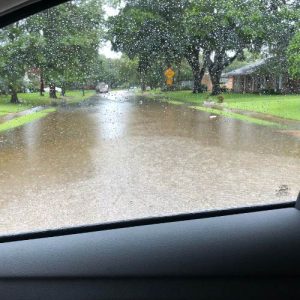Understanding the Scope of Houston’s Disaster Recovery
In the wake of a devastating disaster, such as Hurricane Harvey in 2017, the city of Houston faced immense challenges in terms of recovery and rebuilding. The magnitude of this disaster prompted an urgent need for effective disaster management strategies and comprehensive recovery efforts.
Houston’s disaster recovery encompasses a wide range of initiatives aimed at restoring the city’s infrastructure, economy, and community. From repairing damaged homes and businesses to implementing long-term resilience plans, the city has embarked on a journey to rebuild stronger than ever before.
This section delves into the various aspects of Houston’s disaster recovery, shedding light on the scope and scale of these efforts. We will explore how the city has mobilized resources, engaged stakeholders, and leveraged innovative approaches to facilitate post-disaster rebuilding.
By understanding the scope of Houston’s disaster recovery, we can gain valuable insights into the challenges faced by communities in similar situations and learn from their experiences. Moreover, it allows us to appreciate the resilience and determination exhibited by both individuals and organizations involved in this ongoing process.
Join us as we delve into Houston’s journey toward recovery and discover how this vibrant city is bouncing back from adversity with unwavering strength.
The Impact of Natural Disasters on the City of Houston
 The city of Houston has experienced the devastating impact of natural disasters, most notably Hurricane Harvey. The effects of this catastrophic event, including extensive flood damage and widespread destruction, have left a lasting mark on the city and its residents.
The city of Houston has experienced the devastating impact of natural disasters, most notably Hurricane Harvey. The effects of this catastrophic event, including extensive flood damage and widespread destruction, have left a lasting mark on the city and its residents.
Hurricane Harvey made landfall in August 2017, causing unprecedented rainfall and resulting in severe flooding throughout Houston. The damage was immense, with homes, businesses, and infrastructure severely affected. The recovery efforts that followed required significant resources and collaboration from various stakeholders.
In the aftermath of Hurricane Harvey, the city of Houston has taken steps to improve its natural disaster preparedness. Recognizing the importance of being proactive in mitigating future risks, initiatives have been implemented to enhance emergency response systems, strengthen infrastructure resilience, and increase public awareness about disaster preparedness.
The impact of natural disasters like Hurricane Harvey serves as a powerful reminder of the importance of disaster preparedness and resilience. By learning from past experiences and investing in preventive measures, Houston is working towards becoming better equipped to handle future challenges posed by such events.
As we move forward, it is crucial for communities to prioritize disaster preparedness efforts by implementing effective strategies that focus on early warning systems, evacuation plans, infrastructure improvements, and community engagement. By doing so, we can minimize the impact of natural disasters on our cities and protect our communities from potential devastation.
The Role of Government Agencies in Houston’s Disaster Recovery
 Government agencies play a crucial role in the recovery efforts following a disaster, and Houston is no exception. In the wake of natural disasters such as hurricanes or floods, government agencies like FEMA (the Federal Emergency Management Agency) step in to provide assistance programs to affected individuals and communities.
Government agencies play a crucial role in the recovery efforts following a disaster, and Houston is no exception. In the wake of natural disasters such as hurricanes or floods, government agencies like FEMA (the Federal Emergency Management Agency) step in to provide assistance programs to affected individuals and communities.
FEMA assistance programs offer financial aid, temporary housing, and other resources to help residents rebuild their lives. These programs are designed to provide support during the recovery process and ensure that those affected have access to essential services.
In addition to federal assistance, local government initiatives also play a significant role in Houston’s disaster recovery. City and county officials work tirelessly to coordinate relief efforts, allocate resources, and implement strategies for rebuilding damaged infrastructure. Their involvement ensures that the recovery process is well-coordinated and efficient.
Furthermore, local government initiatives often focus on long-term planning for future disasters. This includes implementing measures such as improved infrastructure resilience, emergency preparedness training for residents, and community engagement programs aimed at increasing disaster awareness.
Collaboration between federal agencies like FEMA and local government entities is crucial to ensuring an effective response to disasters and facilitating a smooth recovery process. By working together, these agencies can pool their resources and expertise to provide comprehensive support for Houston’s residents during times of crisis.
Community Resilience: How Houstonians Come Together During Times of Crisis
 In times of crisis, the strength and resilience of a community are truly put to the test. From homelessness to families needing rental assistance, Houston has faced its fair share of challenges. But it has consistently demonstrated its ability to come together and support one another during difficult times.
In times of crisis, the strength and resilience of a community are truly put to the test. From homelessness to families needing rental assistance, Houston has faced its fair share of challenges. But it has consistently demonstrated its ability to come together and support one another during difficult times.
One of the key factors contributing to Houston’s remarkable community resilience is its robust network of support. When disaster strikes, Houstonians rely on their strong community bonds and well-established support networks to provide assistance and comfort. From neighbors helping neighbors to local organizations mobilizing resources, the spirit of solidarity runs deep within this vibrant city.
Volunteer efforts play a crucial role in Houston’s response to crises. Whether it’s helping tenants navigate the end of the eviction moratorium, the willingness of citizens to step up and lend a helping hand is truly inspiring. Whether it’s distributing supplies, providing shelter for those in need, or participating in search and rescue missions, Houstonians have shown time and time again that they are ready to take action when their community needs them most.
Moreover, what sets Houston apart is its citizen-driven recovery initiatives. Recognizing that long-term recovery requires more than just immediate relief efforts, residents have taken it upon themselves to initiate projects aimed at rebuilding their neighborhoods and restoring normalcy. These grassroots initiatives not only help address immediate needs but also foster a sense of empowerment among residents as they actively participate in shaping the future of their communities.
In conclusion, the way Houstonians come together during times of crisis exemplifies the true spirit of community resilience. Through strong support networks, volunteer efforts, and citizen-driven recovery initiatives, this city has proven time and again that it can weather any storm with unity and determination.
Innovative Solutions for Disaster Recovery in the City of Houston
In the wake of natural disasters, cities like Houston, Harris County, Fort Bend, and others are increasingly turning to innovative solutions to enhance disaster recovery efforts. By embracing smart city technologies and sustainable rebuilding practices, Houston can not only rebuild but also become more resilient in the face of future disasters.
Smart city technologies play a crucial role in disaster recovery by leveraging data and analytics to improve preparedness and response. These technologies enable real-time monitoring of critical infrastructure, such as bridges, roads, and buildings, allowing authorities to identify potential vulnerabilities and take proactive measures to mitigate risks. By harnessing the power of sensors, IoT devices, and data analytics, Houston can create a more robust infrastructure that is better equipped to withstand future disasters.
Additionally, sustainable rebuilding practices are essential for long-term resilience. Incorporating green building techniques and materials can help reduce the environmental impact while ensuring that structures are better able to withstand extreme weather events. From energy-efficient designs to utilizing renewable resources, these practices not only contribute to a more sustainable future but also enhance the city’s ability to bounce back after a disaster.
By combining smart city technologies with sustainable rebuilding practices, Houston can create an ecosystem that prioritizes resilience and preparedness. Leveraging data-driven insights allows for targeted interventions during emergencies while adopting environmentally friendly approaches ensures long-term sustainability. With these innovative solutions in place, Houston can confidently face future challenges with greater efficiency and effectiveness in its disaster recovery efforts.
Economic Revitalization: Restoring Business and Infrastructure in Houston

In the wake of a disaster such as the one Houston experienced, economic revitalization becomes crucial for restoring business and infrastructure. Small business recovery programs play a vital role in providing assistance to local businesses that have been affected by the disaster. These programs offer financial support, resources, and guidance to help businesses recover and thrive once again.
However, rebuilding infrastructure is equally important to ensure long-term economic growth. Investments in infrastructure projects not only create jobs but also attract investments from both local and international sources. By improving transportation networks, upgrading utilities, and enhancing public facilities, Houston can position itself as an attractive destination for businesses looking to invest in post-disaster rebuilding projects.
Attracting investments for these rebuilding projects requires strategic planning and effective communication of Houston’s potential for growth. Highlighting the city’s resilience and commitment to rebuilding can instill confidence in investors who are seeking opportunities in emerging markets. Additionally, showcasing the benefits of investing in Houston’s infrastructure can further incentivize private sector involvement.
By combining small business recovery programs with substantial infrastructure investments, Houston has the opportunity to not only restore its economy but also create a stronger foundation for future growth. With careful planning and collaboration between government entities, private sector stakeholders, and community organizations, Houston can emerge from this challenging period with renewed vitality and become a model for economic revitalization efforts worldwide.
Lessons Learned and Best Practices from Houston’s Disaster Recovery Journey
Houston’s journey in disaster recovery has been a remarkable one, filled with valuable lessons and best practices that can be applied to future scenarios. One of the key strategies that worked exceptionally well was the collaboration between various stakeholders involved in the recovery process.
The city of Houston understood the importance of bringing together government agencies, non-profit organizations, businesses, and community leaders to effectively address the challenges faced during the recovery phase. By fostering strong partnerships and open lines of communication, they were able to leverage each other’s strengths and resources.
Another crucial aspect that contributed to Houston’s successful recovery was its proactive approach to disaster management. They recognized the need for comprehensive planning, including pre-disaster mitigation efforts and post-disaster response strategies. This allowed them to minimize damage and expedite recovery efforts when disaster struck.
Furthermore, Houston prioritized community engagement throughout their journey. They actively sought input from residents and incorporated their feedback into their decision-making processes. This inclusive approach not only empowered individuals but also ensured that recovery initiatives aligned with the needs and aspirations of those affected.
Houston’s experience serves as a valuable case study for other cities grappling with similar challenges. By emphasizing collaboration between stakeholders, adopting proactive disaster management strategies, and prioritizing community engagement, cities can build resilient systems capable of weathering even the most severe disasters.
In conclusion, Houston’s disaster recovery journey offers invaluable lessons learned and best practices that can guide future endeavors in effective disaster management worldwide. The power of collaboration cannot be underestimated when it comes to overcoming adversity and building resilient communities ready to face any challenge head-on.
Conclusion: Moving Forward towards a Resilient Future for the City of Houston
In conclusion, it is evident that the city of Houston must strive towards a resilient future in order to address the challenges posed by climate change and ensure sustainable development. By implementing effective strategies for climate change mitigation, such as reducing greenhouse gas emissions and promoting renewable energy sources, Houston can play a crucial role in mitigating the impacts of climate change.

Jensen Patrick, a 39-year-old housing and rental assistance specialist, was born and raised in the small town of Eau Claire, Wisconsin. He pursued his education in Social Policy at the University of Wisconsin-Madison, where he became deeply interested in the intricacies of housing laws and their impact on communities. Jensen has spent nearly fifteen years working in various capacities within local government in Wisconsin, developing and implementing programs that support affordable housing and prevent homelessness. His work has earned him recognition as a practical and compassionate advocate for underprivileged populations. Outside of his professional life, Jensen is an avid fisherman and enjoys weekend trips to the Great Lakes with his wife and twin daughters, where they teach the girls the value of conservation and enjoying nature.


